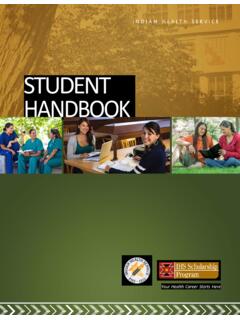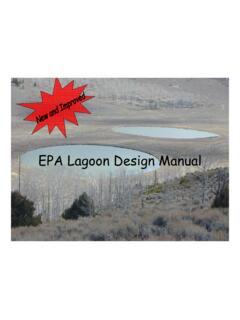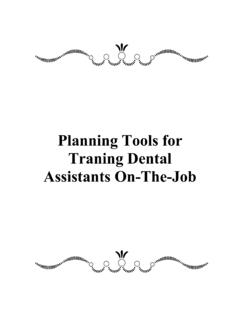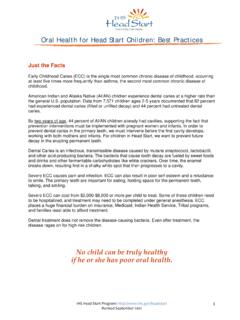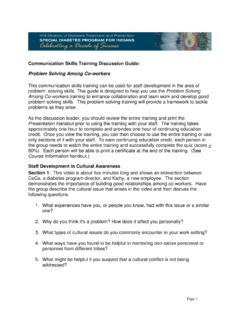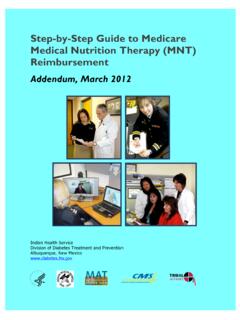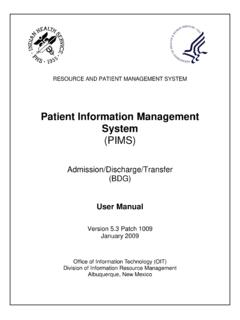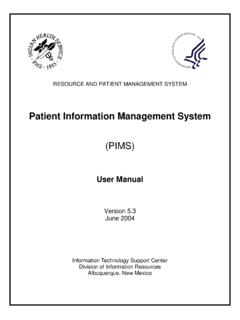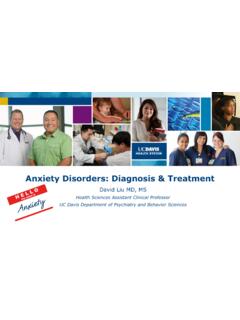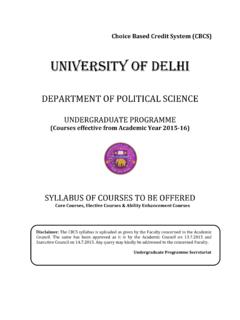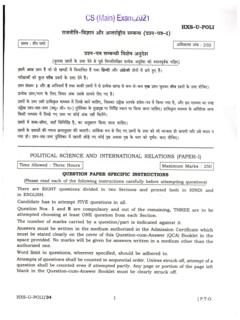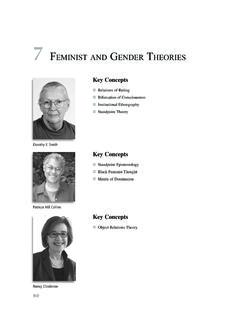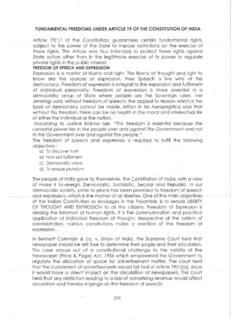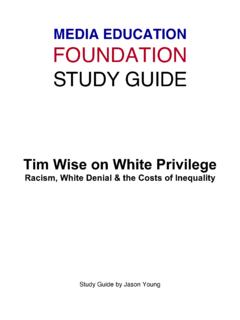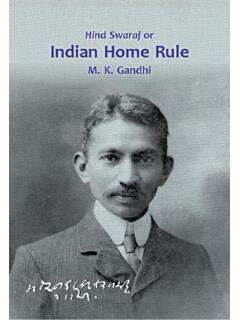Transcription of Pediatric Mental Status Exam - Indian Health Service
1 PediatricMentalStatusExamMarthaJ. Molly Faulkner,PhD,CNP,LISWU niversit y of NewMexico, Deptof Psychiatry, Division of CommunityBehavioral HealthAgendaMentalStatus Exam What Is aMental Status Exam? GeneralGuidelines WhoDoesa Mental StatusExam? ElementsofMentalStatus Exam Tools SummaryObjectives Recognizethemental statusexam(MSE) asbotha psychiatricandneurolo gic evaluation. Identifyelementsofthe pediatricMSE. Outline, as semble,refineandconduct theMSEin a systematic mannerfor Mental Status Exam? Mental statusexamination in USAormental stateexaminationin therest oftheworld,abbreviated MSE, is animportantpartoftheclinical assessmentprocessin a Mental Status Exam?
2 (cont d) A structured way ofobserving and de scribing apatient'scurrent stateofmind, under the domains ofDomainState ofMindAppearance(dress, cleanliness,slim,obese,posture, eyecontact,quality) thought Processes(goaldirected, circumstantial, concrete,derailed, disorganized)Attitude(demeanor,friendly, hostile,agitated, relaxed) thought Co ntent(unremarkable,day sevents)Behavior/Motoric (wnl, hy peractive,slow, vegetative,lethargic)Perception(hallucin ations, oddpe rceptions, paranoia)MoodandAffect (happy,anxious, sad, manic, bright,congruent, expansive)Co gnition(above , average,below, delays)Speech(speed, rhythm, volume, prosody)Insight andJudgment(limited,age appropriate, good, poor, nil)WhatIsa Mental Status Exam?
3 (cont d) Onecomponentofa neurolo gicalormentalhealth/psychiatricassessmen t. Alearnedclinicalskill, not aninnateaptitude Requireseffortto develop andpracticeto maintainDefinition The MSEoriginates from anapproach topsychiatryknown as descriptive psychopathology ordescriptivephenomenologywhich developedfrom the work of the philosopherand a Germanps ychiatrist andphilosopherwhohada stronginfluenceonmodern theology, the onlyway tocomprehenda patient's experi ence isthrough hisorherown descript ion(throughanapproachofempathicandnon- theoretical enquiry)
4 , asdi stinctfromaninterpretive orpsychoanalyticapproachwhichassumes the analystmightunderstandexperi ences orprocesses ofwhich the patient is unaware, suchasdefense mechanismsor unconsciousdrives. MSE is a blendofempathicdescriptivephenomenologya ndempiricalclinical is too oftenoverlooked thesedays,andis asessentialtogood clinicalpracticeasauscultation, palpation, andpe Rapport-Welcome TheChild-Have parentin roomif soothingto child-Privacy- cl ose door-Basic Human Comforts-Calming andRespectfulDemeanor-EncourageOpen Communication-Acknowledge andVal idate Chil d s Dis tres s/ConcernsGeneralGuidelines(continued)
5 Ask Open EndedQuestions AllowClienttoExplainThingsinHis /HerOwnWords Encourage to Elaborate,Explain Avoid Interrupting GuideInterviewas necessary Avoidasking why? insteadask, help meunderstand. Li sten andObservefor Cuesfrom ClientGenera l Guidelines(cont d) MSE is morethan simply a meansofgathering information. It is alsotherapeutic,the first contactwithpatient . MSE setsthestage foryourfuture , warm,yet neutralcanbe very soothingeven to achild who is very agitated, depressed, frightened, orangry. Youmay be rushed anddistractedbyotherthings, but yourpatient will oftenrememberyourfirstencounterevenyears later.
6 Empathy Not synonymouswithlikingthepatient Rather, it reflects ourappreciationthatanotherpersonis suffering andexperiencing difficulty, andneeds thefull benefitofourcareandexpertise. Conducting the MSEThe routineMSEin 15 30minutes,Probes Cognition Emotions Behavior Motor ActivityExaminationtakes longerto teach and describe than it doesto perform. Thefirst MSEwitha patientservesasreferencepointagainst whichallsubsequent exams by thesameclinicianorothers will becompared, An examinerneeds to train herself/himselfsothat her/hisexaminations areconsistentovertimeandasobjectiveas possibl e.
7 Purpose- obtain acomprehensive cross -sectionaldescriptionofthe patient's mentalstate, which, whencombined with the biographicaland historical information of thepsychiatrichistory, allowsthe clinicianto makean acc uratediagnosisandformulation, which arerequired for coherent treatment formation coll ected through acombinationofdirectandindirect means: unstructuredobservation while obtaining the biographical and socialinformation, focused questions aboutcurrentsymptoms MentalStatus Exam?Trained Nurses Counselors Therapists Physicians Psychiatrists NursePractitionersElementsofMSEI.
8 Appearance, Attitude,Behavior, s ofMSE(cont d) FunctioningXI. Judgment andInsightI. Appearance, Attitude,Behavior,and SocialIn teractions Dress(ageap propr iate?) Easein Separationfrom Parent MannerIn Relating (regressed?) Attention Span Speech andLanguageAppearance Doesthe childappearto be well-nourishedandwell-developed; is heoverweight ortoothin? Is the child well-groomed,well-dressedand attentiveto personal hygiene? Who accompanies the child? Are they sitting,standing, lyingdown? Eyecontact andrelatedness?II. MotoricActivity Hyperactive Still Fidgets Into EVERYtoy Gross(la rgemusclegroups) or Fine(small musclegroups) Motor CoordinationIIIMood Howdoyoufeel; thisis patient ssubjectiveself-report andis bestpresentedasdirect quotesin thepatient sownwords(eg, Ifeelangry.)
9 Fantasies, Feelings,andInferredConflicts Nonverbal Cluesto Feelings Clues to Depression AnxietyIVAffect Does thepatientdisplaythenormally expectedrangeoffacial expressiveness -a narrowingorconstrictionofaffect -a flattening ofaffect?IVAffect(cont d)Does thefacialexpressivi ty showlability(rapidlychangingmood,tearful , difficult to control); is thelabilitymarked?Is facialexpressivity andaf fectualdisplaysappropriatewithrespectto: prevailingmood, ideationalcontent?V Speech Think aboutmusicanddescribethemusicalqualities of speech ~ rat e, rhythm,loudness andtonality.
10 ~note unusual pausesor latencies, articulationproblems, andstutterin g andstammering~ Processes Listen! Flowandproduction Paucity Overproductive Rapid Coherent/Incoherent Understandable? thought Processes(continued) Dothey: ~respondto questions in a logical,relevant coherent andgoal-directedmanner? ~givetoo much, unimportantdetail(ie, circumstantial)? ~skipfromtopicto topicnot elaborating fullyonanyoneofthem(ie, tangential)?ThoughtProcess es(cont d) repeat words, phrases and thoughts and have difficulty switching topics (ie perseverative)?
